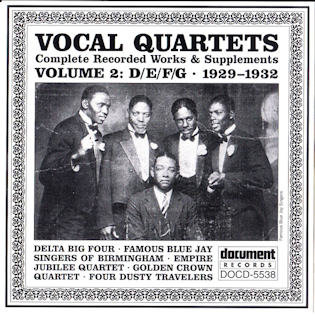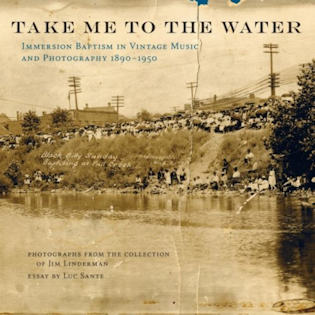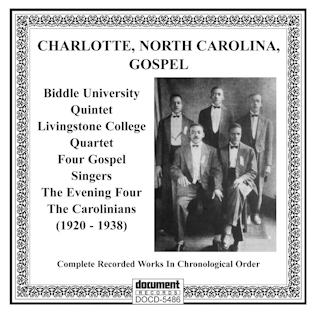 A B C D E F G H I J K L M N O P Q R S T U V W X Y Z
A B C D E F G H I J K L M N O P Q R S T U V W X Y Z
To help with further browsing click on the large ‘Initial’ to return to the Early Gospel Singers Introduction, or click another initial to take you to details of more early gospel singers.
____________________________________________________________________________________________________________________________
| Name: | Brother Willie Eason |
| Location: | Georgia |
| Born: | 1921 |
| Died: | 2005 |
| Biography Synopsis: |
Started the sacred steel guitar style when he introduced the lap steel guitar to the Church of the Living God during the late 1930s (see more below). Willie was born in 1921 in the LaCrosse community of Schley County, Georgia, near Ellaville and Plains. His family moved to Philadelphia, PA before he was a year old. In Philadelphia circa 1936, his older brother, Troman (1905-1949), took lessons from a Hawaiian steel guitarist named Jack, whom he heard playing live over the radio. Inspired by Troman’s success with the steel, Willie took up the instrument and played it in the House of God, Keith Dominion church his family attended. By 1940, he began to travel the eastern US from New York to Miami to play for revivals, church meetings, and later, on street corners. He recorded seven 78 rpm records, including two on which the Soul Stirrers–arguably the most popular black gospel quartet of the day–sang backup as Willie sang lead and played fills on his Epiphone Electar. Willie was tremendously popular among the House of God congregants and the inspiration for dozens, if not hundreds, to take up the electric steel guitar. Today the steel guitar (which many House of God congregants still refer to as the “Hawaiian guitar”) is the dominant instrument in that church as well as a related organization, the Church of the Living God, Jewell Dominion. Source: Steel Guitar Forum __________________________________ Willie Claude Eason (1921 -2005) “The father of Sacred Steel Music”. Willie was the tenth child born to Henry and Addie Eason. Willie’s elder brother Troman taught him to read music at the urging of their Mother. He was known as “Little Willie and his talking guitar” because he developed his own style, playing single notes as he mimicked the African American singing voice. Willie became a consummate performer and church musician playing a tremendous role in the formative years of the Keith dominion steel guitar tradition. He is responsible for placing the steel guitar in a position of central importance in Keith dominion church worship services. Willie also traveled with the Gospel Feast Party at the request of Bishop J.R. Lockley. Eason was multi- talented playing steel guitar and the piano. Eason was a great business man, landlord, booking agent, and gospel concert promoter. Willie made seven 78 –rpm records; four on the Queen record label, two for Aladdin, and one on the Regent record label. He recorded with the Soul Stirrers Quartet group, and the Gospel Trumpeters. Willie died of pneumonia in St. Petersburg, Florida on June 16, 2005. Source: SacredStrings.com
__________________________________ Notes on ‘Sacred Steel’ : Sacred Steel is a musical style and African-American gospel tradition that developed in a group of related Pentecostal churches in the 1930s. The Church of the Living God, was founded in 1903 by Mary Magdalena Lewis Tate. Following her death in 1930, the church divided into three branches, known as the Keith, Jewell and Lewis dominions. The steel guitar was embraced in the worship of two of these dominions, the Keith Dominion (officially, The House of God Which Is the Church of the Living God the Pillar and Ground of the Truth Without Controversy), headquartered in Nashville and the Jewell Dominion (Church of the Living God, Pillar and Ground of the Truth, Which He Purchased With His Own Blood, Inc.) headquartered in Indianapolis. Brothers Troman and Willie Eason introduced lap steel guitar to worship services in place of the traditional organ. This new instrument was met with great enthusiasm and taken up by others including the Bishop J.R. Lockley. The three toured together and later Willie put the new style down on record, recording a total of eighteen sides in the 1940s and 50s. Since then, Sacred Steel has grown and flourished within the Keith and Jewell Dominions in churches in at least 22 states, including Alabama, Connecticut, Florida, Georgia, Indiana, Michigan, Mississippi, North Carolina, New Jersey, New York, South Carolina and Tennessee. The most famous practitioner is Robert Randolph of the Robert Randolph and the Family Band. Randolph, the son of a deacon and a minister, took up pedal steel guitar at 17. Just seven years later, he went on to become one of the most original and talented practitioners of the Sacred Steel form. Willie Eason’s nephew Aubrey Ghent had also become a celebrated steel guitarist, preserving the sacred steel tradition and bringing it to a wider audience. Ghent’s father, Henry Nelson, was also schooled by Eason and played sacred steel for over 50 years, sharing the stage with Sister Rosetta Tharpe and Mahalia Jackson. Unlike Robert Randolph and the Family Band who have crossed over to doing more secular music, Aubrey Ghent has stayed closer to the gospel roots of tradition, as have many of the steel guitarists of the Jewell Dominion. Source: Wikipedia |
| Recording career: | |
| Most popular song(s): | There’ll Be No Grumblers There |
| Musical Influences: | |
| References / links: | YouTube Audio Clip |
| Images: | 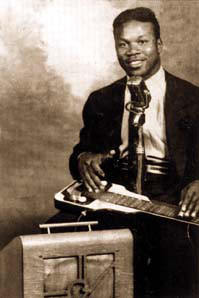 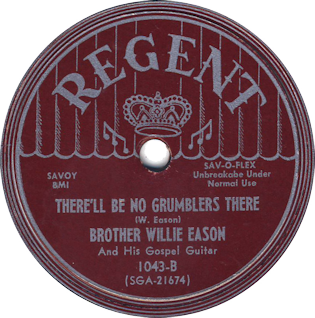 |
| Name: | The Eley Sisters |
| Aka: | |
| Location: | Cleveland, Ohio |
| Biography Synopsis: | All female sextet comprising Rose Pressley, Willie Pressley, Joenida Eley, Hattie Eley, Grace Eley, and Jessie Eley. |
| Recording career: | |
| Most popular song(s): | |
| Musical Influences: | |
| References / links: | ‘Cleveland’s Gospel Music’, Frederick Burton, Arcadia Publishing 2003 |
| Images: |
| Name: | The Elite Jewels |
| Aka: | “Songbirds of The North” |
| Location: | Cleveland, Ohio |
| Biography Synopsis: | Formed in 1936 comprising: Maggie Cannone, Mildred Blair, Agnes Jackson, Etta Mae Hurd, Senester Whatley, and Edith Jones.”The Elite Jewels were organized in Cleveland, Ohio in 1936 by Mrs. Etta Mae Hurd, Ms. Johnnie Mae Feagen and Mr. Leroy Gaynot. The group’s talent to sing was soon discovered by many of Cleveland’s finest musicians and directors and shortly thereafter they were nicknamed the “Songbirds of the North”. Since 1948, the Elite Jewels have had their own weekly Radio broadcast in Cleveland. The Elite Jewels have performed with many of the greatest singers in the country such as, The Caravans, Shirley Caesar, Inez Andrews, The Gospel Harmonettes, and the late Reverend James Cleveland and many more. The Elite Jewels have recorded with five major recording companies: Palada, Peacock, Simpson, Songbird, and Savory Records, and more recently with Trinity Record Company, Inc.”. – Trinity Record Company, Inc. (http://www.trinityrecordcompany.com) |
| Recording career: | 1936 – 2003 |
| Most popular song(s): | “I Was Standing By The Bedside of A Neighbor” |
| Musical Influences: | |
| References / links: | ‘Cleveland’s Gospel Music’, Frederick Burton, Arcadia Publishing 2003 |
| Images: |
| Name: | Elkins Payne Jubilee Singers |
| Location: | ? |
| Biography Synopsis: | Male gospel quartet, that recorded for Paramount, OKeh, Cameo, Gennett, QRS, and Brunswick in 1923-1929. |
| Recording career: | 1920s – 1930s |
| Most popular song(s): | When The Saints Go Marching In |
| Musical Influences: | |
| References / links: | Discography of American Historical Recordings |
| Images: | 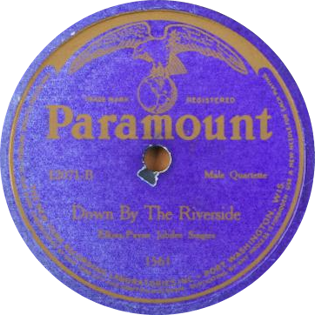 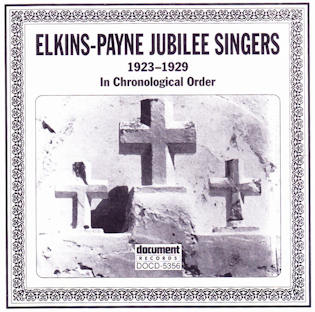 |
| Name: | Brother Claude Daniel Ely |
| Aka: | Coined as the King Recording Label’s “Gospel Ranger” of the Appalachian Mountains. |
| Location: | Ely pastored various churches in Kentucky, Virginia and the Cincinnati, Ohio area. |
| Born: | 22nd July 1922, Pucketts Creek, Virginia. |
| Died: | 7th May 1978 |
| Biography Synopsis: | Brother Claude Daniel Ely, coined as the King Recording Label’s “Gospel Ranger” of the Appalachian Mountains, was born in Pucketts Creek, Virginia. He was the first Pentecostal Holiness recording artist to be signed to a major recording label for strictly sacred music and songs.
Receiving fame for his penned song, “There Ain’t No Grave (Gonna Hold My Body Down)”, Ely’s musical style and spiritual influence still exist today among both secular and sacred music enthusiasts. Although Bozie Sturdivant was the first to record Brother Claude Ely’s tune in 1941 with the help of the US Library of Congress’ field recordings, Ely had penned the song in 1934. King Records of Cincinnati helped Brother Claude Ely copyright the song in 1953. Many Hollywood entertainers and musical artists have acknowledged their admiration and fascination for Brother Claude Ely. Often music historians attest that other musical artists cite Brother Claude Ely as having been a positive influence on their works as well. Elvis’ mother Gladys brought Elvis Presley to Ely’s tent revivals. Artists recording Brother Claude Ely’s songs include Elvis Presley and Johnny Cash. Robert Duvall’s self-produced movie entitled The Apostle also integrated Brother Claude Ely’s music on its soundtrack. Ely pastored various churches in Kentucky, Virginia and the Cincinnati, Ohio area. Ely also hosted a radio program entitled “The Gospel Ranger Show” which aired across the southeastern portion of the United States. Many of Ely’s religious followers and numerous admirers still exist today in the Appalachian mountains. Ely’s great nephew, Dr. Macel Ely II, wrote an official biography on Brother Claude Ely’s life. The book is based upon oral history ascertained from over 1,000 personal interviews Dr. Ely conducted with musical artists, ministers, and Appalachian residents who remembered the singer/preacher. The book is a “set” consisting of the earlier mentioned book and a music CD. The set is entitled Ain’t No Grave: The Life & Legacy of Brother Claude Ely was released in 2010 by Dust-to-Digital out of Atlanta, Georgia. |
| Recording career: | |
| Most popular song(s): | “There Ain’t No Grave (Gonna Hold My Body Down)” |
| Musical Influences: | |
| References / links: | http://www.claudeely.net/bio.html |
| Images: |
| Name: | Empire Jubilee Quartet |
| Location: | |
| Biography Synopsis: | 1929 |
| Recording career: | |
| Most popular song(s): | Wade In De Water |
| Musical Influences: | |
| References / links: | Discography of American Historical Recordings |
| Images: | 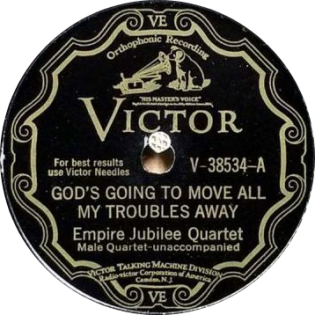 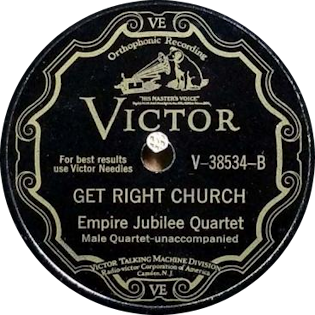
|
| Name: | Excelsior Quartet |
| Location: | |
| Biography Synopsis: | At their first recording session the Excelsior Quartette covered the Norfolk Jazz Quartet’s “Jelly Roll Blues” and cut two other “stage” numbers that are redolent of the minstrel tradition: “Kitchen Mechanic Blues” with its “ain’t you glad you’re brownskin – chocolate to the bone” theme, and “Roll Them Bones” which reinforces the stereotype of the black man as a “crap-shooting fool”. Within days the group re-recorded “Jelly Roll Blues” and “Kitchen Mechanic Blues” for the Gennett label, a practice common in the early days of recording when artists generally received an immediate flat fee for sides that were released rather than royalties accrued over a period of time. In another two weeks they were back recording for OKeh, this time beginning their session with six religious pieces that seem to have been intended mainly for white consumption. All six titles were standards of the “jubilee quartet” repertory including hoary chestnuts like “Nobody Knows The Trouble I See” and “Golden Slipper”. “l Am The King Of The Sea” includes the verse:
“Mind my sister how you walk on the cross (Crossing the Red Sea) Your foot might slip and your soul’ll be lost” Their last session was in May 1922 for Harry Pace’s black owned and operated Black Swan label where they re-cut “Coney Island Baby” and the ever- popular “Jelly Roll Blues”. It should be mentioned in passing that the Excelsior Quartet cited in the black press in 1890 (see “100 Years From Today” by Lynn Abbott, Ray Funk and Doug Seroff -78 Quarterly No. 6) are not the same group as on this compilation, but an earlier quartet operating out of Denver, Colorado with wholly different personnel. Source: Document Records |
| Recording career: | |
| Most popular song(s): | |
| Musical Influences: | |
| References / links: | |
| Images: | 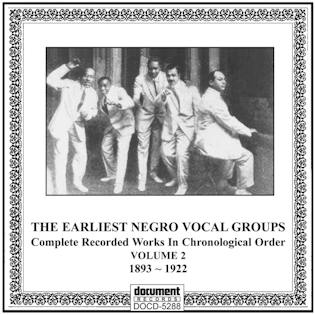 |
____________________________________________________________________________________________________________________________
 A B C D E F G H I J K L M N O P Q R S T U V W X Y Z
A B C D E F G H I J K L M N O P Q R S T U V W X Y Z
To help with further browsing click on the large ‘Initial’ to return to the Early Gospel Singers Introduction, or click another initial to take you to details of more early gospel singers.
____________________________________________________________________________________________________________________________
Please Note:
As this is a continuously developing website, several entries only give the names with no biographical details. Please be patient as these entries are included for completeness, indicating the details are ‘coming soon’ and will be added when time allows.
If there are any early (pre war) gospel singers missing from the lists that you think should be included, please email the details to alan.white@earlygospel.com. Thank you in advance for your assistance.

